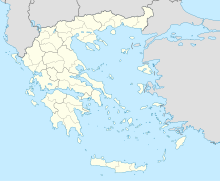Mycenae
37.730555555622.7569444444Coordinates: 37° 43′ 50″ N, 22° 45′ 25″ E
![]()
The title of this article is ambiguous. For other meanings see Mycenae (disambiguation).
Mycenae, also Mykenai, Mykenä, obsolete Mycenä or poetically Myzen (ancient Greek Μυκήνη Mykḗnē or Μυκήνα Mykḗna, also as plural Μυκῆναι Mykḗnai (f. pl.); Latin Mycenae; Modern Greek Μυκήνες Mykínes), was one of the most important cities of Greece in preclassical times, and the Mycenaean culture was named after it. The city was situated north of the plain of Argos on a hill. From here one overlooked and controlled the land route between the southern Peloponnese and the Isthmus of Corinth, which connects the Peloponnesian peninsula with the rest of the mainland, initially with Attica and Boeotia. Since 1999 Mycenae has been a UNESCO World Heritage Site together with Tiryns.
History
Neolithic
|
| |
| Location of Mycenae in Greece |
Single Neolithic sherds dating to before 3500 BC were found. The site was already inhabited, but the stratigraphy was destroyed by later construction.
Early Bronze Age
The beginning of the Early Bronze Age, on the soil of later Greece also called Early Helladic (FH), is today dated to the last third of the 4th millennium. There is evidence of contacts, especially with the Cyclades and their equally rich and ancient culture. Some researchers also assume the immigration of Indo-Germanic speakers or "proto-Greeks" during this period.
Middle Bronze Age
From the period between 2100 and 1700 B.C. there are isolated finds of sherds, among them the so-called Minyan pottery characteristic of the Middle Helladic (MH). The first burials in pits or stone box tombs in the west of the Acropolis, partly still within the earliest fortification walls, date from the 18th century BC.
Late Bronze Age
Since a more precise dating is only possible for a few finds (including an Egyptian scarab amulet), and dendrochronological investigations are also still pending, the events are listed here according to the excavation findings, arranged according to the conventional divisions of the Late Helladic (SH). Mycenae experienced its greatest flourishing in the 14th and 13th centuries B.C. The city remained continuously inhabited until the 5th century.
Late luminescence I
Outside the enclosure wall, in burial circle B, ten stone box graves in still Middle Helladic style and several deeper shaft graves with burials in stone boxes were found. Rich grave goods indicate the high status of the dead. Drinking vessels and bones were found in the mounds above the graves, offering conclusions about an extraordinary funerary meal. Stelae crowned the burial mounds.
In burial circle A, which was integrated into the fortification wall of the upper city in the second half of the 13th century BC and was originally part of a larger necropolis originating in the Middle Helladic period, six large shaft tombs were found containing the remains of nine female, eight male and two juvenile bodies. The grave goods were even richer than in burial circle B. The presence of engraved and inlaid swords and daggers as well as spear and arrow points leave no doubt that warrior princes and their families are buried here. Among the artifacts found here are the gold mask of Agamemnon, the so-called Nestor cup of Mycenae, and weapons. In addition, there were some smaller tombs in burial circle A, most of which, however, were destroyed by Schliemann's early excavations.
Late Helladic II
From 1600 BC tholos tombs replaced shaft tombs as the main burial form of the upper class. Alan Wace divided the nine tholos tombs at Mycenae into three groups according to their architecture. The oldest - called the Cyclopean Tomb, the Tomb of Epano Phournos, and the Tomb of Aigisthos - he dated to SH IIA. The older shaft tombs were preserved with some difficulty during this period, suggesting that they were by now considered the cultural heritage of the ruling families. Thus, modern archaeologists found the shaft tombs largely untouched - unlike the more obvious tholos tombs, all of which had been looted in ancient or later times.
Late Helladic III
Around 1350 BC the wall was rebuilt in cyclopean style. The last palace on the Acropolis was built in SH IIIA2, with previous buildings completely demolished or built over. The architecture of palaces at this time was similar throughout southern Greece. There was a throne room in the form of a megaron with a central fireplace under a roof opening, around which stood four columns supporting the roof. Next to it was a throne, and the plastered walls and floors were decorated with frescoes. This room was always entered from a courtyard with a portico, and the courtyard in turn was reached from a terrace by a large staircase. In 2014, a stone fragment weighing about 50 kg was discovered below the upper town in the bed of the dried-up river Chavos, which is probably part of the royal throne from the second half of the 13th century.
| Mycenae in hieroglyphics | |||||||
|
In the temple within the walls a scarab of the Egyptian queen Teje, who was married to pharaoh Amenophis III, was found together with a statue from SH IIIA2 or B1. The relations of Amenophis III to the princely seat of Mycenae are confirmed by an inscription in the temple of Amenophis III. However, the reign of Amenophis III is placed late in SH IIIA1. Thus, it is likely that Amenophis (or his wife) sent the scarab to an earlier generation of Mycenaean rulers before their descendants deposited it in the temple (two to three generations later).
The second Tholos group - the tomb of Kato Phournos, the Panagia tholos and the lion tomb - was dated by Alan Wace between SH IIA and SH IIIB. The last group includes the Treasury of Atreus, the Tomb of Clytemnestra and the Tomb of the Genii, it was dated to SH IIIB by means of a sherd found under the doorstep.
In the middle of SH IIIB, around 1250 BC, the wall was extended to the west and burial circle A was now located within the walls. At the same time the well-known lion gate was erected at the main entrance. Above the crossbeam the lion relief was placed in the form of a relief triangle in order to distribute the load of the masonry on the side walls. An unadorned gate was built to the north. Some of the few excavated houses outside the walls date from the same period. They are the House of Shields, the House of the Oil Merchant, the House of the Sphinxes, and the West House; they were probably both dwellings and workshops.
Somewhat later, towards the end of SH IIIB, in the late 13th century, the citadel was extended once again. In the northeast, the wall was extended and provided with a sally port. In addition, an underground cistern was built within the walls at a depth of 15 metres, which could be reached via a secret passage with 99 steps. The cistern was fed by a spring above the city through a tunnel that was also built. During SH IIIB Mycenae had extended its sphere of influence to Pylos in the west, Crete in the south and Athens and Thebes in the north.
Downfall
From 1200 BC, at the transition from SH IIIB to SH IIIC, the decline of Mycenae began, which was to forfeit its supremacy during the 12th century BC. Like all palaces in southern Greece, that of Mycenae was destroyed shortly after 1200 BC. Pottery and its decoration changed very rapidly during this period, and craftsmanship and art sank to a lower level. The settlement shrank, but the citadel as well as the lower city remained inhabited. In archaic times, a temple to Hera was built on the highest point.
In 480 BC, 80 Mycenaeans took part in the Battle of Thermopylae. A year later Mycenae, together with Tiryns, sent 400 fighters to the battle of Plataiai. In 468 BC, the Argives conquered Mycenae, carried off the inhabitants and razed the walls. During the Hellenistic period the city was repopulated and a theatre was built. After that, the site was repopulated only briefly. In the 3rd century BC Mycenae was finally abandoned. However, by Roman times its now uninhabited walls had become a tourist attraction throughout the Roman Hellenistic world due to the literary canonization of the Iliad.
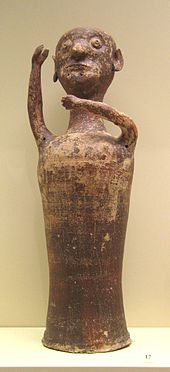
Anthropomorphic figure, between 1250 and 1180 BC.
_NAMA_Tablette_7671.jpg)
Writings from Mycenae, written in the linear script B (after 1500 B.C.)

View into the valley

Drawing after a golden seal from Mycenae: A goddess sits at the foot of a sacred tree, surrounded by adorants and sacred emblems
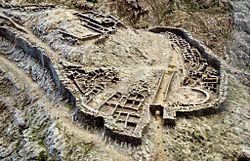
Model of the ruins
Places of interest
Today, the ruins of the Mycenaean upper city are preserved and excavated. Worth mentioning are the remains of the cyclopean ring wall and the Lion Gate. It was named after the two lions depicted on a relief above the gate entrance and formed the main entrance to the castle. The gate was probably built around 1250 BC. A second smaller, but not completely preserved gate without decorative stones is located in the northern area of the ancient complex.
The wall has three construction phases: The first can be dated around 1350 BC. Then, in the middle of the 13th century, the defences were strengthened to the south and west. Around 1200 BC, the wall was again strengthened and extended with the construction of cisterns and storerooms. Only scanty remains of the Mycenaean palace on the highest point of the upper city exist, since a fire destroyed large parts of it; it was also intensively built over in later times. The throne room was a large megaron-shaped building. A steep ramp led up to the palace, most of which has been preserved, and because of the gradient of about 20 per cent it could only be negotiated on foot.
Of great importance are two large burial circles (A and B), which were marked by stelae. In each of the burial circles a whole series of shaft graves were found with very rich grave goods such as terracottas, clay vessels, golden masks, jewellery made of gold sheet etc.. In five shaft graves 17 bones (mainly of men) were found. Grave circle A, which had already been discovered by Heinrich Schliemann, was added to the castle wall during later extensions of the castle complex. Burial circle B was not excavated until the early 1950s. Some of the graves found in it are even older than those in burial circle A. They date from the late 17th or early 16th century BC and are thus from the very beginning of the Mycenaean period. The earliest graves in burial circle A date from about the middle of the 16th century.
Furthermore, nine domed tombs of beehive-like shape have been discovered so far. Until today, they are also called "treasure houses" in research and arbitrarily named after mythological figures who are said to have ruled in Mycenae according to the Iliad (e.g. "treasure house of Atreus", "treasure house of Clytemnestra"). They had a vaulted narrow entrance (called a dromos) and were built by piling up large, precisely hewn stones weighing up to twelve tons.
Remains of Mycenae were already known in more detail since a French scientific expedition in 1822. However, it is only the excavations carried out since Heinrich Schliemann that have made possible more precise knowledge of the ancient royal castle and the structures belonging to it, such as the tombs and the lower city. Various finds suggest a strong influence of the Minoan culture on the Mycenaean Greeks. But influences from Egypt are also conceivable, especially in the area of the burials; an attempted mummification could be proven in one burial.
The extensive lower city has been little explored. After the decline of Mycenae in the fourth century B.C., only a small inhabited village remained to this day at the foot of the old complex, which was also called Charváti in the meantime. In 2007, a museum was completed underneath the old castle complex, where some of the finds made here can be seen.

The newly built museum below the excavation site
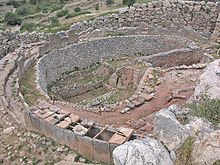
Grey ring A

Entrance to the cistern
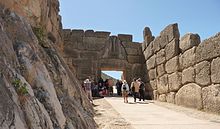
Visitors at the Lion's Gate, 2013
Questions and Answers
Q: What is Mycenae?
A: Mycenae is an archaeological site in Greece.
Q: Where is Mycenae located?
A: Mycenae is located about 90 km southwest of Athens, in the northeastern Peloponnese.
Q: What was Mycenae in the second millennium BC?
A: In the second millennium BC, Mycenae was one of the most important centers of early Greek civilization with a strong army.
Q: What is the time period referred to as Mycenaean Greece?
A: The time of Greek history from about 1600 BC to about 1100 BC is called Mycenaean Greece.
Q: How important was Mycenae to early Greek civilization?
A: Mycenae was one of the most important centers of early Greek civilization with a strong army.
Q: What is the significance of Mycenae in Greek history?
A: Mycenae was a significant center of early Greek civilization and a strong military presence during the Mycenaean period.
Q: What is the relationship between Mycenae and Greek history?
A: Mycenae is a significant location in Greek history, particularly during the Mycenaean period when it was a major center of early Greek civilization and had a strong military presence.
Search within the encyclopedia
